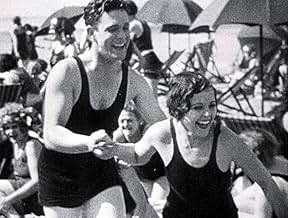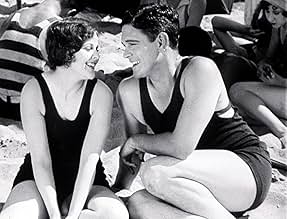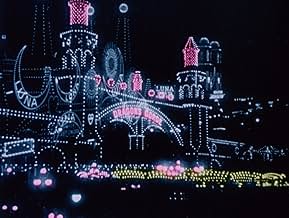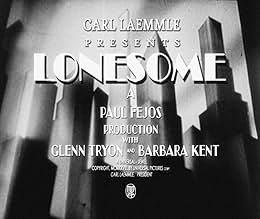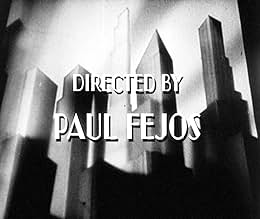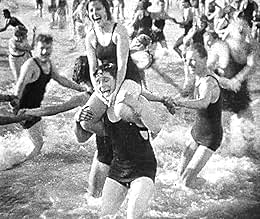AVALIAÇÃO DA IMDb
7,7/10
2,8 mil
SUA AVALIAÇÃO
Adicionar um enredo no seu idiomaTwo lonely people in the big city meet and enjoy the thrills of an amusement park, only to lose each other in the crowd after spending a great day together. Will they ever see each other aga... Ler tudoTwo lonely people in the big city meet and enjoy the thrills of an amusement park, only to lose each other in the crowd after spending a great day together. Will they ever see each other again?Two lonely people in the big city meet and enjoy the thrills of an amusement park, only to lose each other in the crowd after spending a great day together. Will they ever see each other again?
- Direção
- Roteiristas
- Artistas
- Prêmios
- 1 vitória no total
Gusztáv Pártos
- Romantic Gentleman
- (as Gustav Partos)
Henry Armetta
- Ferris wheel guy
- (não creditado)
Edgar Dearing
- Cop
- (não creditado)
Louise Emmons
- Telephone Caller
- (não creditado)
Fred Esmelton
- Swami
- (não creditado)
Jack Raymond
- Barker
- (não creditado)
Churchill Ross
- Telephone Caller
- (não creditado)
Avaliações em destaque
Silent movies had a unique appeal to viewers in early cinema in that they forced the public to use their imaginations to fill in the gaps when the characters were speaking to one another. Silents didn't require extensive inter titles to get the jest of the actors' conversations. Consequently, the actors became larger than life because they weren't dragged down by imperfections in tonality and delivery most mortals possess.
So when the first 'talkies' starting dribbling out of Hollywood after October 1927's "The Jazz Singer" was released, the voices emitting from the screen must have been jarring to those not used to hearing their acting idols speak. One of the first feature films after "The Jazz Singer" to contain a bit of audible dialogue was June 1928's "Lonesome." The film was initially released as a silent, then in September edited with three sequences of actual talking. The first talking sequence is 30 minutes into the film when Mary (Barbara Kent) and Jim (Glenn Tryon), meeting for the first time at Coney Island's amusement park, are sitting on the beach saying how lucky they are meeting each other. As one modern-day critic describes it, "They suddenly seemed very childlike and embarrassing compared to their 'silent selves,' perhaps even silly and sappy. They seemed flawed and human once I heard their voices. It was an interesting way for me to think about silence versus sound in cinema, as this film allows one to essentially to see both types in the same film."
Film critic Andrew Saris claimed "Lonesome" was "a tender love story in its silent passages, but crude, clumsy and tediously tongue-tied in its talkie passages." There is one sequence in the dialogue portion that justifies the talkie addition. Jim gets hauled into the police station after a cop accused him of roughing him up after he tried break through the crowd to get to Mary, who had fainted. The police commander, debating whether to charge Jim, at first plays hardball. But when Jim pleads his case, you can hear the change of tone of the adjudicating official when he decides to let him go. An inter title could never convey such a friendlier timbre of the officer.
The appeal of "Lonesome" is that the Paul Fejos-directed movie addresses a universal problem focused on singles living a solitary life in the big city. Jim, a keypunch machine operator at a city factory, and Mary, a telephone operator, work long hours. Their opportunities to meet the opposite sex are few. Fejos, a former medic with the Austrian Army on the front lines of World War One front lines whose love for theater transformed into directing film, used a bag of special effects tricks early on to cleverly portray the pair, using double exposures to show their routine day. The two do link up at the park and have a magical time staring into each other's eyes. Fejos colors his celluloid with hand-tinted and stencil-color segments to illustrate their romantic state.
Once "Lonesome" was released in June, Universal Studio executives felt adding the talking sequences to the movie would add some pizzazz. The studio borrowed a Movietone News sound recording truck from Fox Pictures, owners of the audio system, on the pretext it was conducting sound tests when actually it was filming the three audible sequences. Fejos wasn't involved in those shoots, which didn't dampen critics' enthusiasm for the film, citing it as the highlight of his career. "Lonesome" was a great success for Universal, partly because of the revolutionary insertion of those "talking" segments.
So when the first 'talkies' starting dribbling out of Hollywood after October 1927's "The Jazz Singer" was released, the voices emitting from the screen must have been jarring to those not used to hearing their acting idols speak. One of the first feature films after "The Jazz Singer" to contain a bit of audible dialogue was June 1928's "Lonesome." The film was initially released as a silent, then in September edited with three sequences of actual talking. The first talking sequence is 30 minutes into the film when Mary (Barbara Kent) and Jim (Glenn Tryon), meeting for the first time at Coney Island's amusement park, are sitting on the beach saying how lucky they are meeting each other. As one modern-day critic describes it, "They suddenly seemed very childlike and embarrassing compared to their 'silent selves,' perhaps even silly and sappy. They seemed flawed and human once I heard their voices. It was an interesting way for me to think about silence versus sound in cinema, as this film allows one to essentially to see both types in the same film."
Film critic Andrew Saris claimed "Lonesome" was "a tender love story in its silent passages, but crude, clumsy and tediously tongue-tied in its talkie passages." There is one sequence in the dialogue portion that justifies the talkie addition. Jim gets hauled into the police station after a cop accused him of roughing him up after he tried break through the crowd to get to Mary, who had fainted. The police commander, debating whether to charge Jim, at first plays hardball. But when Jim pleads his case, you can hear the change of tone of the adjudicating official when he decides to let him go. An inter title could never convey such a friendlier timbre of the officer.
The appeal of "Lonesome" is that the Paul Fejos-directed movie addresses a universal problem focused on singles living a solitary life in the big city. Jim, a keypunch machine operator at a city factory, and Mary, a telephone operator, work long hours. Their opportunities to meet the opposite sex are few. Fejos, a former medic with the Austrian Army on the front lines of World War One front lines whose love for theater transformed into directing film, used a bag of special effects tricks early on to cleverly portray the pair, using double exposures to show their routine day. The two do link up at the park and have a magical time staring into each other's eyes. Fejos colors his celluloid with hand-tinted and stencil-color segments to illustrate their romantic state.
Once "Lonesome" was released in June, Universal Studio executives felt adding the talking sequences to the movie would add some pizzazz. The studio borrowed a Movietone News sound recording truck from Fox Pictures, owners of the audio system, on the pretext it was conducting sound tests when actually it was filming the three audible sequences. Fejos wasn't involved in those shoots, which didn't dampen critics' enthusiasm for the film, citing it as the highlight of his career. "Lonesome" was a great success for Universal, partly because of the revolutionary insertion of those "talking" segments.
Lonesome is like the much more charming, if slightly less ambitious (and at the very end a bit too cute) cousin of Sunrise. It's appeal is in its simplicity, but where Sunrise was about a couple breaking apart and coming back together, this is much more streamlined and less tragic (though it does go for some tragic beats in the last twenty minutes of its slim 70-minute run-time): boy is lonely, girl is lonely, both work working-class jobs (factory/phone operator, what else in New York city in 1928?), they both decide separately after their (so-called!) friends go off on their own adventures to go to the beach and amusement park - is it Coney Island? I can't imagine it being anywhere else - and boy and girl meet as the boy tries to show off doing games. And that's it, that's the movie, and why it stands out (and got a sort-of restoration and Criterion treatment) is its presentation by its director.
I don't know much about Pal (Paul) Fejos except that he directed silent films and somewhat into the 1930's, and then sort of faded away into obscurity. It's a shame since a film like Lonesome shows his talents clearly: he has a keen sense of editing and that way that silent filmmakers sometimes had to super-impose images (perhaps a chip off the Abel Gance block perhaps, but not as ambitious), in particular when he's setting up the hustle/bustle of the city and then later in the film when things get more harrowing with the characters. That is to say when, inevitably, the main conflict is that they are separated in that great sea of people that makes up a massive crowd in a city (where, as the man, Jim, notes at one point, is so strange that you're surrounded by so many but still feel so alone).
The charm in the film comes in how the couple on screen - Barbara Kent and Glenn Tryon - are together; they're kind of like if you had one of those romantic "leads" in those really early Marx brothers movies, only they don't sing and the man is funny in that amusing- lightly- sarcastic way (i.e. bragging about his "six acres on Wall street" at first, which we and the girl knows isn't true, but it's fun to play along). Actually, speaking of that, this is an experimental film at heart for a number of reasons. It appears at first to be a silent film, and for 90% of it it surely is, and is shot like one with that film speed we associate with silent cinema on the whole (that kind of slightly-sped-up speed where its rhythm is distinctly of its cameras and era), and we know this because 10% of the film, more or less, is a *sound* film. No, really, we suddenly move from what is the obvious fluid camera style and wide shots of the crowds and intensity that comes with a camera that moves freely to what is clearly static shots in a studio so the actors are right under a microphone... and the acting is just as static.
That's not totally fair; this is considered, at least according to the trivia, one of the very first films to ever incorporate sound. On that level it's certainly extraordinary and important, but the problem is that it becomes jarring with the rest of the film which is shot with such passion and excitement (it's also frankly weird to hear the actor's speaking voices, whereas before, like I do with a lot of silent movies, I can think of my own voices for the actors that do not sound so... stilted). One of the sound scenes is also one where I wasn't sure if a cop was being sarcastic or not; our man Jim has been taken away by the cops after a roller-coaster ride where Mary, the girl, fainted and had to be taken away but Jim got separated and got rough with a cop. For a moment it seems like he'll be put away, but Jim pours his heart out (with some, I'm sorry, cringe-inducing lines), and the cop's reaction is hard to read since it sounds totally "pfft yeah right"... but then they let him go. Very strange.
But these aren't major complaints for a film that has so much to offer outside of those things. This is a movie that's joy is in its purity, that it's about these two people and how they meet and suddenly all of the usual problems of their everyday lives - the work, the drudgery, the intensity of being around so many people getting on/off the subways or being in the traffic - can float away since they have one another. And there are some moments of experimentation that do work, mostly involving (also, again, a touch of daring with Fejos) color: there's tinted scenes here, which isn't unusual for a silent film, but here it's how the colors are used, over the amusement park scenes to illuminate the lights at night, the performers in the park, the vibrancy that the night off a beach in the city brings.
There are so many moments of rich filmmaking, so much hope that this couple is able to inspire in a short amount of time, and because of the simplicity we're able to invest ourselves into their bond as it gets closer (maybe a little *too* quick, one might want to argue, falling in love within a day), that one can almost forgive a cutesy ending. Almost.
I don't know much about Pal (Paul) Fejos except that he directed silent films and somewhat into the 1930's, and then sort of faded away into obscurity. It's a shame since a film like Lonesome shows his talents clearly: he has a keen sense of editing and that way that silent filmmakers sometimes had to super-impose images (perhaps a chip off the Abel Gance block perhaps, but not as ambitious), in particular when he's setting up the hustle/bustle of the city and then later in the film when things get more harrowing with the characters. That is to say when, inevitably, the main conflict is that they are separated in that great sea of people that makes up a massive crowd in a city (where, as the man, Jim, notes at one point, is so strange that you're surrounded by so many but still feel so alone).
The charm in the film comes in how the couple on screen - Barbara Kent and Glenn Tryon - are together; they're kind of like if you had one of those romantic "leads" in those really early Marx brothers movies, only they don't sing and the man is funny in that amusing- lightly- sarcastic way (i.e. bragging about his "six acres on Wall street" at first, which we and the girl knows isn't true, but it's fun to play along). Actually, speaking of that, this is an experimental film at heart for a number of reasons. It appears at first to be a silent film, and for 90% of it it surely is, and is shot like one with that film speed we associate with silent cinema on the whole (that kind of slightly-sped-up speed where its rhythm is distinctly of its cameras and era), and we know this because 10% of the film, more or less, is a *sound* film. No, really, we suddenly move from what is the obvious fluid camera style and wide shots of the crowds and intensity that comes with a camera that moves freely to what is clearly static shots in a studio so the actors are right under a microphone... and the acting is just as static.
That's not totally fair; this is considered, at least according to the trivia, one of the very first films to ever incorporate sound. On that level it's certainly extraordinary and important, but the problem is that it becomes jarring with the rest of the film which is shot with such passion and excitement (it's also frankly weird to hear the actor's speaking voices, whereas before, like I do with a lot of silent movies, I can think of my own voices for the actors that do not sound so... stilted). One of the sound scenes is also one where I wasn't sure if a cop was being sarcastic or not; our man Jim has been taken away by the cops after a roller-coaster ride where Mary, the girl, fainted and had to be taken away but Jim got separated and got rough with a cop. For a moment it seems like he'll be put away, but Jim pours his heart out (with some, I'm sorry, cringe-inducing lines), and the cop's reaction is hard to read since it sounds totally "pfft yeah right"... but then they let him go. Very strange.
But these aren't major complaints for a film that has so much to offer outside of those things. This is a movie that's joy is in its purity, that it's about these two people and how they meet and suddenly all of the usual problems of their everyday lives - the work, the drudgery, the intensity of being around so many people getting on/off the subways or being in the traffic - can float away since they have one another. And there are some moments of experimentation that do work, mostly involving (also, again, a touch of daring with Fejos) color: there's tinted scenes here, which isn't unusual for a silent film, but here it's how the colors are used, over the amusement park scenes to illuminate the lights at night, the performers in the park, the vibrancy that the night off a beach in the city brings.
There are so many moments of rich filmmaking, so much hope that this couple is able to inspire in a short amount of time, and because of the simplicity we're able to invest ourselves into their bond as it gets closer (maybe a little *too* quick, one might want to argue, falling in love within a day), that one can almost forgive a cutesy ending. Almost.
10Varlaam
This film is outstanding.
A man and woman leave their respective rented rooms for work. He's a "punch presser"; she's a switchboard operator. After work, neither one feels up to joining friends; they just feel too ... single. But they both head to Coney Island. They meet, fall in love, get separated, return home distressed. A plot that simple, even clichéd, does not appear to hold much promise.
But the energy! The pacing is so frenetic. There's constant movement on camera, clocks ticking, crowds scurrying, throngs crushing, machines stamping, carnivals, streamers, roller coaster rides. Moments of relative calm come when the lovers are together.
The thrilling impersonality of the urban maelstrom has hardly been better depicted. I came away thinking it was one of the best things I've seen.
If you've seen "The Devil and Miss Jones", the Jean Arthur / Robert Cummings comedy from 1941, then you can't help but remember the Coney Island beach scene where everyone is packed in together with barely room to move.
Well, this film has a scene just like that one. In fact, the greater part of the film is that way. You're never so alone as when you're in a crowd. These scenes are funny, but they do make their point.
I saw a restored print of "Solitude" (as it was titled) with colour tinting and three sound sequences, courtesy of Cinematheque Ontario. The sound segments are just awful, so typical of the very earliest sound, but perhaps they're a blessing in disguise. The extraordinary quality of the silent film is spotlighted by the awkwardness of these three brief scenes: Jim and Mary on the beach, Jim and Mary near the midway, Jim at the police station.
The ultimate restoration of this elusive marvel would make the film silent throughout, liberating it from the stylistic cacophony of the stilted sound sequences.
Neither lead performer, Barbara Kent nor Glenn Tryon, was known to me previously. (Andy Devine is plainly recognizable however.) It seems that Tryon later became the producer of "Hellzapoppin" and "Hold That Ghost". He also holds the only acting credit for a film that anyone at all seems to have seen, "Variety Girl" from 1947. To me, Barbara Kent resembles Paulette Goddard somewhat, while Glenn Tryon looks like a brother to Don DeFore and Bob Cummings.
The screening I attended was the Toronto première of the restoration. Let's hope it now becomes more widely available.
A man and woman leave their respective rented rooms for work. He's a "punch presser"; she's a switchboard operator. After work, neither one feels up to joining friends; they just feel too ... single. But they both head to Coney Island. They meet, fall in love, get separated, return home distressed. A plot that simple, even clichéd, does not appear to hold much promise.
But the energy! The pacing is so frenetic. There's constant movement on camera, clocks ticking, crowds scurrying, throngs crushing, machines stamping, carnivals, streamers, roller coaster rides. Moments of relative calm come when the lovers are together.
The thrilling impersonality of the urban maelstrom has hardly been better depicted. I came away thinking it was one of the best things I've seen.
If you've seen "The Devil and Miss Jones", the Jean Arthur / Robert Cummings comedy from 1941, then you can't help but remember the Coney Island beach scene where everyone is packed in together with barely room to move.
Well, this film has a scene just like that one. In fact, the greater part of the film is that way. You're never so alone as when you're in a crowd. These scenes are funny, but they do make their point.
I saw a restored print of "Solitude" (as it was titled) with colour tinting and three sound sequences, courtesy of Cinematheque Ontario. The sound segments are just awful, so typical of the very earliest sound, but perhaps they're a blessing in disguise. The extraordinary quality of the silent film is spotlighted by the awkwardness of these three brief scenes: Jim and Mary on the beach, Jim and Mary near the midway, Jim at the police station.
The ultimate restoration of this elusive marvel would make the film silent throughout, liberating it from the stylistic cacophony of the stilted sound sequences.
Neither lead performer, Barbara Kent nor Glenn Tryon, was known to me previously. (Andy Devine is plainly recognizable however.) It seems that Tryon later became the producer of "Hellzapoppin" and "Hold That Ghost". He also holds the only acting credit for a film that anyone at all seems to have seen, "Variety Girl" from 1947. To me, Barbara Kent resembles Paulette Goddard somewhat, while Glenn Tryon looks like a brother to Don DeFore and Bob Cummings.
The screening I attended was the Toronto première of the restoration. Let's hope it now becomes more widely available.
A sister of Sunrise and The Crowd, this film is more emotional and poetic than those landmarks and every bit as great. The plot concerns two working class American types, he works in the factory, she works on the intercom who meet by chance on a fairground and fall in love and then lose each other without knowing where the other lives.
The film's beginning is to be treasured, it follows in detail the morning ritual of first the girl and then the man in their respective homes. The effect conveyed is the organization and elegance of women over the tardy, rushed, half-baked activities of men. The love story between the two characters is so beautifully etched and played so naturalistically by the actors(Barbara Kent and Glenn Tryon) that the sense of loss in the latter half of the film is all the more painful and heart-breaking. The film deals with a certain truth about living in a city that has remained constant even after a good 80 years. At once a constant sense of community and at other an equally constant sense of loneliness from being in a crowd.
The film's beginning is to be treasured, it follows in detail the morning ritual of first the girl and then the man in their respective homes. The effect conveyed is the organization and elegance of women over the tardy, rushed, half-baked activities of men. The love story between the two characters is so beautifully etched and played so naturalistically by the actors(Barbara Kent and Glenn Tryon) that the sense of loss in the latter half of the film is all the more painful and heart-breaking. The film deals with a certain truth about living in a city that has remained constant even after a good 80 years. At once a constant sense of community and at other an equally constant sense of loneliness from being in a crowd.
If only this remarkable movie hadn't had the misfortune to be released just when the enthusiasm for sound was sweeping all before it, it would probably have been more appreciated at the time and remembered today as one of the all-time classics. As an expression of the isolation of city life, it builds up an atmosphere of desperation, in spite of its romance with a happy ending. The scene where the boy searches frantically for the girl throughout crowded Coney Island, buffeted this way and that by the uncaring throngs, turned away by the indifferent faces of the amusement park workers, has few equals for anguish. Also unforgettable is the montage that cuts from one to the other of the lovers (who have not yet met) while they are at work, the one at a factory, the other at a telephone switchboard; the motions of the hands and the machines build to a frantic, overwhelming pace.
Unfortunately, before the movie was released it was sadly mangled by the insertion of several sound sequences, which stop the continuity dead with their absolute stasis, and feature dialogue so thunderously inane you have to suspect it was written by the sound technician. Nonetheless, "Lonesome" remains one of the most sophisticated examples of the silent movie, an art form that was killed by sound almost as soon as it had reached maturity.
Unfortunately, before the movie was released it was sadly mangled by the insertion of several sound sequences, which stop the continuity dead with their absolute stasis, and feature dialogue so thunderously inane you have to suspect it was written by the sound technician. Nonetheless, "Lonesome" remains one of the most sophisticated examples of the silent movie, an art form that was killed by sound almost as soon as it had reached maturity.
Você sabia?
- CuriosidadesIt was one of the first motion pictures to have sound and a couple of talking scenes. It was released in both silent and monaural versions. Some scenes in existing original prints of the film are colored with stencils.
- Versões alternativasProduced in both sound and silent versions. The sound version was 6,785 feet in length, and the silent version was 6,193 feet.
- ConexõesFeatured in Fejezetek a film történetéböl: Az amerikai film kezdetei (1989)
- Trilhas sonorasAlways
(uncredited)
Written by Irving Berlin
[Played by dance orchestra at ballroom]
Sung by Nick Lucas
[on Brunswick recording played in last scene]
Principais escolhas
Faça login para avaliar e ver a lista de recomendações personalizadas
- How long is Lonesome?Fornecido pela Alexa
Detalhes
- Tempo de duração
- 1 h 9 min(69 min)
- Mixagem de som
- Proporção
- 1.19:1
Contribua para esta página
Sugerir uma alteração ou adicionar conteúdo ausente



